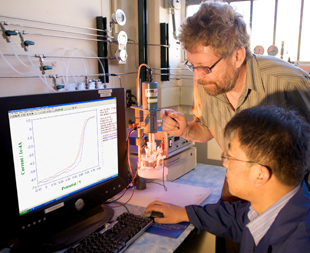
Los Alamos National Laboratory scientists have developed a way to avoid the use of expensive platinum in hydrogen fuel cells, the environmentally friendly devices that might replace current power sources in everything from personal data devices to automobiles.
In a paper published today in Science, Los Alamos researchers Gang Wu, Christina Johnston, and Piotr Zelenay, joined by researcher Karren More of Oak Ridge National Laboratory, describe the use of a platinum-free catalyst in the cathode of a hydrogen fuel cell. Eliminating platinum—a precious metal more expensive than gold—would solve a significant economic challenge that has thwarted widespread use of large-scale hydrogen fuel cell systems.
Polymer-electrolyte hydrogen fuel cells convert hydrogen and oxygen into electricity. The cells can be enlarged and combined in series for high-power applications, including automobiles. Under optimal conditions, the hydrogen fuel cell produces water as a “waste” product and does not emit greenhouse gasses. However, because the use of platinum in catalysts is necessary to facilitate the reactions that produce electricity within a fuel cell, widespread use of fuel cells in common applications has been cost prohibitive. An increase in the demand for platinum-based catalysts could drive up the cost of platinum even higher than its current value of nearly $1,800 an ounce.
The Los Alamos researchers developed non-precious-metal catalysts for the part of the fuel cell that reacts with oxygen. The catalysts—which use carbon (partially derived from polyaniline in a high-temperature process), and inexpensive iron and cobalt instead of platinum—yielded high power output, good efficiency, and promising longevity. The researchers found that fuel cells containing the carbon-iron-cobalt catalyst synthesized by Wu not only generated currents comparable to the output of precious-metal-catalyst fuel cells, but held up favorably when cycled on and off—a condition that can damage inferior catalysts relatively quickly.
Moreover, the carbon-iron-cobalt catalyst fuel cells effectively completed the conversion of hydrogen and oxygen into water, rather than producing large amounts of undesirable hydrogen peroxide. Inefficient conversion of the fuels, which generates hydrogen peroxide, can reduce power output by up to 50 percent, and also has the potential to destroy fuel cell membranes. Fortunately, the carbon- iron-cobalt catalysts synthesized at Los Alamos create extremely small amounts of hydrogen peroxide, even when compared with state-of-the-art platinum-based oxygen-reduction catalysts.
Because of the successful performance of the new catalyst, the Los Alamos researchers have filed a patent for it.
“The encouraging point is that we have found a catalyst with a good durability and life cycle relative to platinum-based catalysts,” said Zelenay, corresponding author for the paper. “For all intents and purposes, this is a zero-cost catalyst in comparison to platinum, so it directly addresses one of the main barriers to hydrogen fuel cells.”
The next step in the team’s research will be to better understand the mechanism underlying the carbon-iron-cobalt catalyst. Micrographic images of portions of the catalyst by researcher More have provided some insight into how it functions, but further work must be done to confirm theories by the research team. Such an understanding could lead to improvements in non-precious-metal catalysts, further increasing their efficiency and lifespan.



